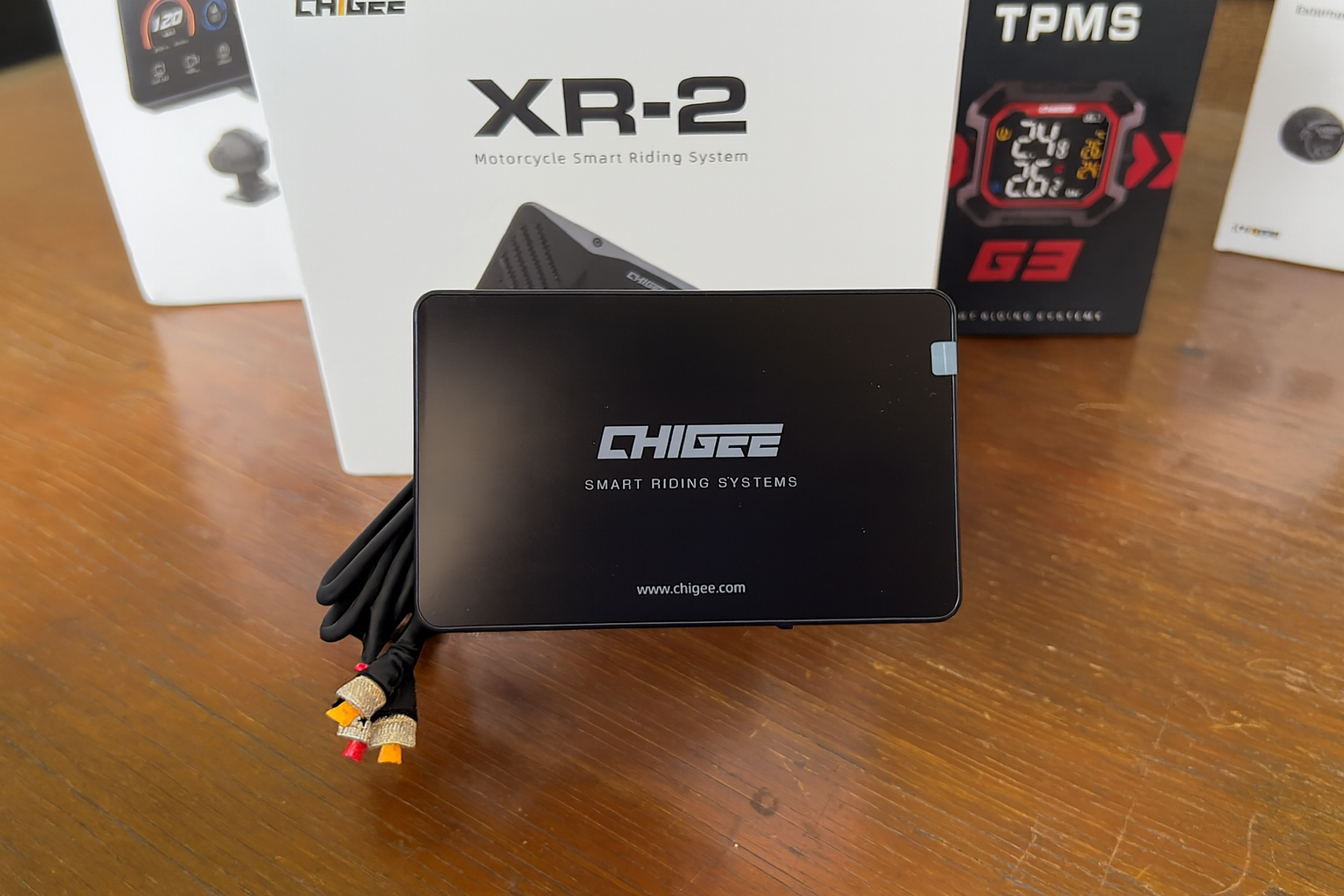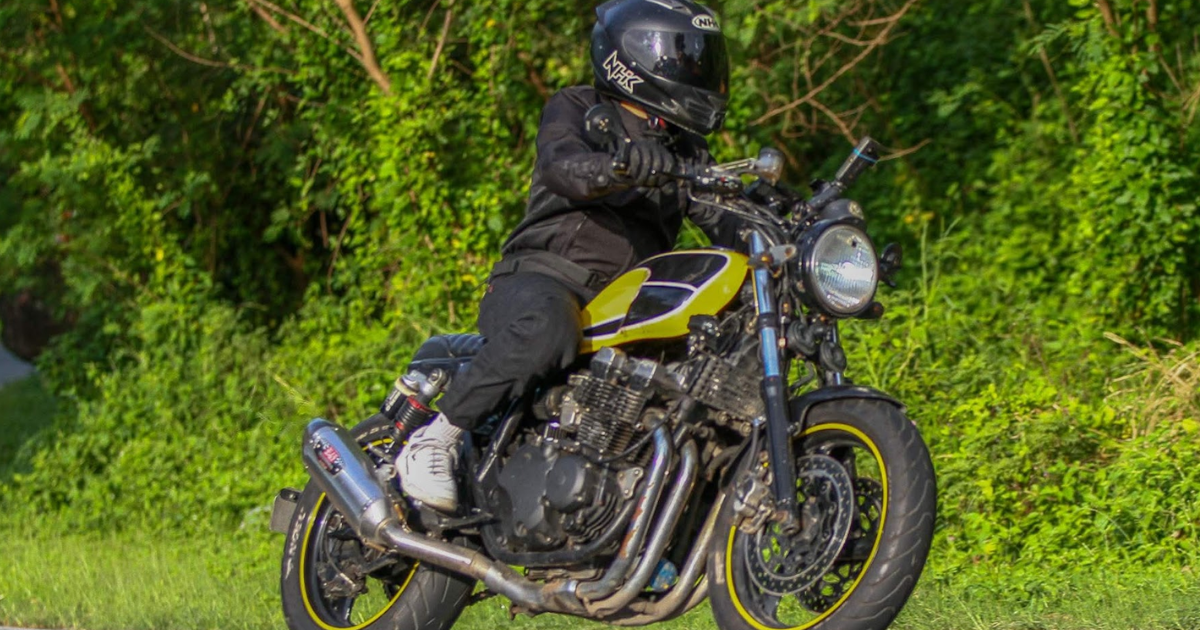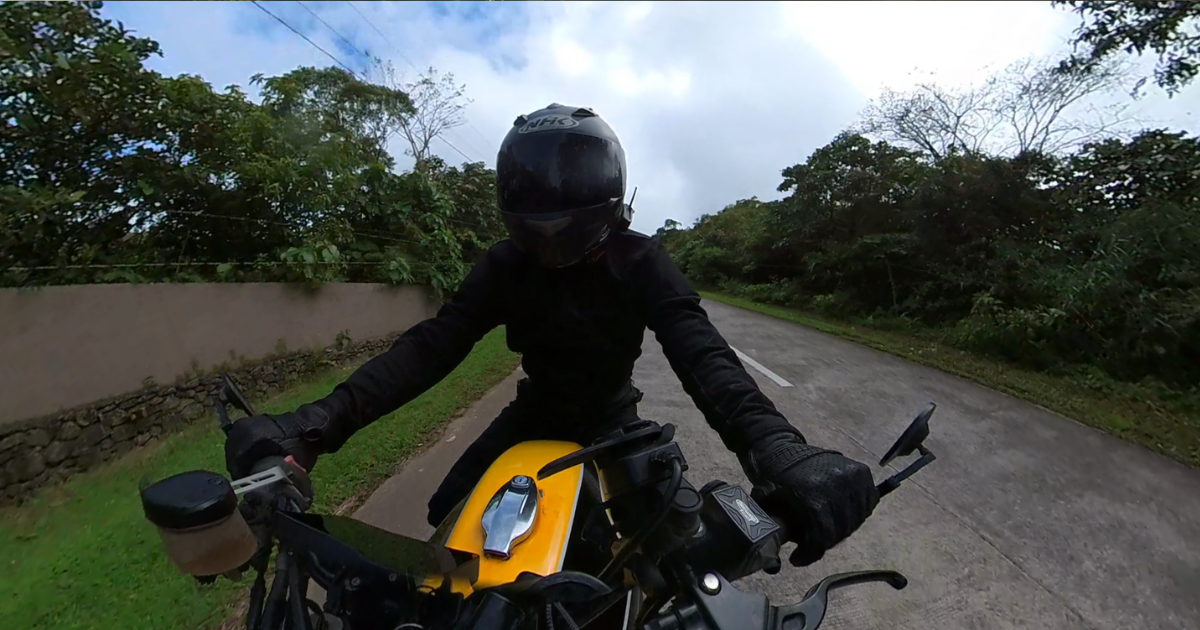
Chigee XR-2 HUD Review: Small Size, Big Motorcycle Features
left for contents
Motorcycle infotainment have long been dominated by bulky systems that cater to large, high-end bikes, leaving riders of smaller motorcycles, like scooters, classic bikes, and sport bikes, with few options. These oversized units often clash with a bike’s aesthetic or offer basic features that fail to meet modern needs. Riders need more than just size — they need functionality tailored to their specific bike, without sacrificing design or performance.
Enter the Chigee XR-2, which I tested on my 1990 Yamaha XJR 400. Unlike other systems, the XR-2 is designed with limited space in mind, offering modern functionality without overwhelming your bike’s setup. This device stands out for its clean installation, proportional design, and focus on delivering only what riders truly need.
The XR-2 is a compact, handlebar-mount CarPlay / Android Auto “smart riding” display and dashcam unit for motorcycles. It features a 4.3-inch touchscreen that mirrors your smartphone interface, dual front/rear cameras for recording, and optional external tire pressure sensors for real-time monitoring. It integrates navigation, ride logging, and safety features into one compact system.
- 1400 nits brightness, daylight ready
- Dual cams for recording + safety
- CarPlay / Android Auto support
- Optional TPMS external sensors
- IP68 water + dust resistant
- More affordable than flagships
- No buttons, needs BT remote
- No blind-spot detection
What makes the XR-2 especially appealing is its balance of features and reliability. It’s not about cramming in every possible option, but about creating a system that delivers essential, high-quality performance while preserving the unique character of each motorcycle.
Understanding Your Bike’s Electronics Needs
Before diving into technical specifications, it’s important to ask: what do you really need from a motorcycle electronics system? If you’re riding a classic bike like my XJR 400, a Harley Sportster, a Honda CB650R, or any smaller displacement machine, your requirements are very different from someone on a BMW R1250GS touring the globe. For those long-haul riders, something like the AIO-5 or AIO-6 might be the better fit, since they’re built for advanced touring needs.
For most riders, the essentials are simple—reliable navigation, the ability to take calls safely, basic dash functions, and maybe a camera for insurance purposes. These are the features that matter most on daily rides, not satellite communication or managing heated gear across multiple zones.
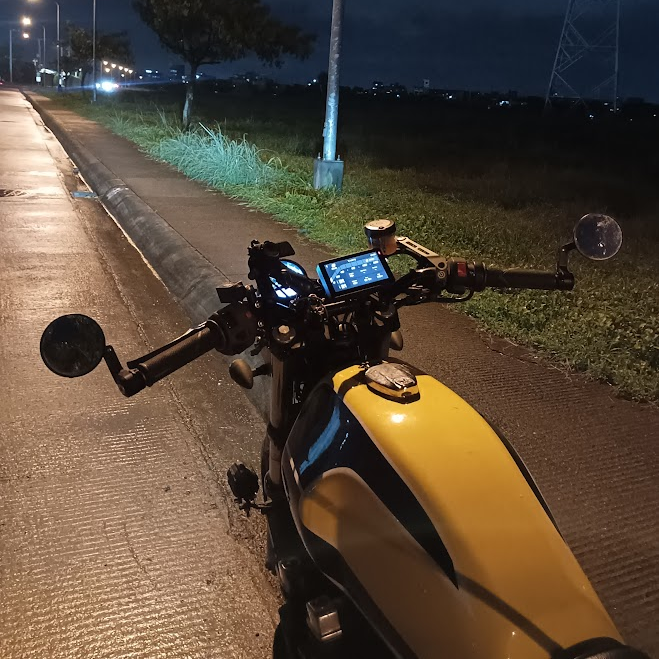
The XR-2 understands this reality and focuses on what riders actually need. Instead of cramming in every possible feature, it delivers those essential functions with precision and reliability, ensuring a great
Design Philosophy and Impact on the XJR 400
The Chigee XR-2 takes a refreshing approach to motorcycle electronics, focusing on integration and purposeful engineering rather than simply adding more features. When I mounted the XR-2 on my 1990 XJR 400, the first thing that stood out was how it seamlessly blended with the bike’s existing design, never overshadowing its aesthetic.
This is a crucial consideration for many riders. I’ve seen countless classic bikes ruined by oversized electronics units that dominate the handlebars and dashboard, transforming the bike’s appearance in a way that doesn’t complement its character. The XR-2’s compact 4.3-inch form factor ensures that it enhances the riding experience without becoming a distracting focal point.

On my XJR 400, with its clean and minimalist design from 1990, the XR-2 looks as though it could have been a factory option if the technology had been available at the time. Its unobtrusive presence is a testament to thoughtful design, allowing the bike’s original character to shine through while still offering modern functionality.
Build Quality That Matches Its Ambitions
What impressed me during my ride on the XJR 400 was how the XR-2 handled the daily challenges that motorcycle electronics face. The IP68 waterproof rating isn’t just a spec—it’s a design philosophy. Motorcycles often operate in harsh environments, and a failure isn’t just inconvenient, it can be dangerous.
During a recent storm on the expressway, I watched rain cascade across the XR-2’s screen, yet it continued to operate without issue. The touch response remained steady, even with wet gloves, and the display brightness automatically adjusted to maintain visibility in varying light conditions.
This kind of reliability gives you confidence, allowing you to focus on the ride rather than worry about whether your electronics will survive the journey. The XR-2 truly proves its worth in different conditions.

The build quality extends beyond just weather resistance. The mounting system integrated cleanly with the XJR’s handlebars without requiring multiple brackets or complex installation procedures. This matters significantly for riders of classic machines who value clean installations and have limited space to work with.
Screen Performance in Demanding Conditions
The 4.3-inch display might seem small compared to tablet-sized units dominating the premium market, but Chigee has optimized this screen for motorcycle use in ways that larger displays often overlook. At 1400 nits brightness, the XR-2 delivers exceptional visibility even in direct sunlight—a crucial capability that proved essential during my daytime rides on the XJR 400.
Smart Map Switching Technology
One feature that proved invaluable on my rides is the automatic Smart Map Switching. When you enter tunnels, pass under trees, or ride into evening conditions, the display automatically adjusts between light and dark modes. It sounds small, but it eliminates distractions, helping you focus on the road and navigation.
The XR-2’s screen responsiveness also stands out. Coming from smartphone-based navigation, the XR-2 feels much quicker. Menu transitions are instant, maps redraw smoothly at highway speeds, and touch inputs register immediately—even with thick gloves.

These features make the XR-2 more intuitive and safer to use. Automatic adjustments and quick responsiveness reduce the need for manual intervention, keeping your attention on riding.
Integrated GPS: The Clean Installation Advantage
Perhaps the most significant design decision Chigee made with the XR-2 was embedding GPS functionality directly into the unit rather than requiring external modules or relying entirely on smartphone connectivity. This integration delivered practical benefits that became apparent the moment I started planning the installation on my XJR 400.
Installation Simplicity on a Classic Bike
With built-in GPS, installing the XR-2 on my XJR 400 was much simpler. There was no need for a separate GPS module, extra cables, or additional components to weatherproof. For riders with classic bikes that have limited space and minimal electronics, this integration cuts down on installation complexity and potential failure points.
The Chigee XR-2 offers reliable ride recording, independently tracking your speed and other ride metrics. It ensures that your ride data is captured continuously, even when you’re out of range or away from other devices.

For a bike like the XJR 400, which lacks modern electrical conveniences, this independence from the phone provides a crucial buffer. It ensures you’re never left stranded, relying on a system that may fail when you need it most.
Curious how rugged devices perform when the road disappears? We reviewed motorcycle navigation adventure devices tested by long-distance riders in different conditions.
Optional TPMS: Real-Time Tire Monitoring for Enhanced Safety
One of the most valuable optional accessories for the XR-2 is the Tire Pressure Monitoring System (TPMS). While not included with the base unit, this add-on transforms the XR-2 into a comprehensive safety monitoring system that provides real-time tire pressure and temperature data directly on the display.
Why TPMS Matters for Motorcycle Safety
Tire pressure monitoring is crucial on motorcycles, as proper tire pressure impacts fuel economy, handling, braking performance, and overall safety. Motorcycles are much more sensitive to pressure variations than cars, and a sudden loss of pressure can be dangerous at high speeds.
The Chigee TPMS system addresses this by continuously monitoring both front and rear tire pressure and temperature. The sensors wirelessly transmit data to the XR-2, where it’s displayed alongside your navigation and other ride information, allowing you to keep a close eye on tire health while riding.

This integration offers an added layer of safety, ensuring you’re always informed about your tire status without taking your attention away from the road. It’s a practical feature that enhances the riding experience with peace of mind.
Benefits on the Bike
When I fitted the Chigee XR-2 on my XJR 400, the TPMS felt like an extra I probably wouldn’t use much. I usually check my tires before heading out, but once I’m riding, I never really think about pressure—it’s just something I assumed was fine.
One weekend, though, I overinflated my rear tire without realizing it. Out on the road, the XR-2 showed the pressure sitting higher than recommended. I already knew what that meant—less grip, harsher ride, and quicker tire wear. Without the TPMS, I would’ve ridden the whole day not knowing, but instead I pulled into a station, bled out the excess air, and the bike immediately felt more planted and smoother.

Since then, I’ve come to appreciate having real-time pressure and temperature displayed right next to my navigation. It keeps me honest about tire health and reminds me that even small changes in pressure can affect handling and safety. What I thought was just a bonus feature has become one of the most useful parts of the XR-2.
Installation and Integration
The TPMS sensors are easy to install, directly attaching to the tire valves, replacing the standard valve caps. The process is straightforward and requires no modifications to the bike. Once paired with the XR-2, the system operates automatically, providing alerts for pressure drops, temperature spikes, or sensor malfunctions.
What impressed me most was how seamlessly the TPMS data integrates into the XR-2’s interface. The tire information appears as a small overlay on the display, ensuring it doesn’t interfere with navigation or other functions, yet remains easily accessible when needed.

This thoughtful integration ensures that tire health information is always at hand without disrupting the ride experience, offering convenience and peace of mind.
Customizable Alerts and Thresholds
The TPMS system lets you set custom pressure and temperature thresholds based on your specific tires and riding conditions. For the XJR 400, I configured alerts for both low and high pressure, ensuring I’d be notified of gradual leaks or over-inflation before they became serious issues.
The alert system is smart and unobtrusive, providing visual and audio notifications without being too disruptive. Critical alerts are prioritized and grab immediate attention, while minor variations are gently noted, allowing you to stay informed without interrupting your ride.

This level of customization and intelligence makes the TPMS system both practical and easy to use, giving you peace of mind without distracting you from the road.
Camera System: Dual 1080p Documentation
The XR-2 includes front and rear 1080p cameras that serve dual purposes: recording your rides for enjoyment and providing documentation in case of incidents. While some riders question the necessity of camera systems, the reality is that having objective documentation of road incidents has become increasingly valuable for insurance and legal purposes.
Practical Recording Capabilities
The dual camera setup on the XR-2 captures clear footage both day and night. The front camera provides a rider’s perspective, while the rear camera records following traffic. During my ride on the XJR 400, the recording quality was more than adequate for identifying license plates and documenting incident details without using up too much storage or needing constant memory card management.
What I really appreciate about Chigee’s camera system is its seamless operation. It records automatically as soon as you start riding and stops when the bike is turned off. This transparent approach means you don’t have to constantly manage the system, letting you focus on the ride.

The cameras work in the background, providing reliable documentation without interrupting your riding experience. This effortless recording is a big plus, especially for riders who want peace of mind without the
Connectivity and Smart Features
The wireless Apple CarPlay and Android Auto capability transforms how classic bikes like my XJR 400 can access modern smartphone functionality. Having full CarPlay integration on a 1990 motorcycle feels like bringing a classic bike into the modern era without compromising its essential character.
Wireless Integration Benefits
Wireless connectivity on the XR-2 eliminates the cable management issues that would be especially challenging on the XJR 400’s clean, minimalist design. Without cables, there are no weatherproofing concerns, no wear from constant connection and disconnection, and fewer potential failure points in the electrical system. You simply mount your phone securely on the bike and enjoy smooth integration through the XR-2’s display.
This integration goes beyond just basic functionality. Music playback, navigation updates, call management, and message handling all operate directly through the XR-2’s interface. This centralizes your interactions, reducing the need to handle your phone while riding the XJR.

By keeping everything accessible through the XR-2, you stay connected and focused on the road, all while maintaining the bike’s minimalist aesthetic. Wireless integration enhances convenience without compromising the riding experience.
Dashboard Integration and Information Display
One feature that proves surprisingly valuable during daily riding is the odometer display capability. Having your total mileage and trip information visible on the XR-2’s screen eliminates the need to constantly reference the XJR’s original instrument cluster or maintain separate tracking systems.
Comprehensive Ride Information
The dashboard integration on the XR-2 goes beyond basic odometer functions. It allows you to monitor ride metrics, track multiple trip distances, and keep records of your motorcycle’s usage patterns. For riders of classic bikes like the XJR 400, who need detailed information for maintenance scheduling or simply enjoy tracking their riding habits, these features offer real utility without the need for extra devices or apps.
The display remains clear and easy to read, even in challenging light conditions. The layout is designed to prioritize essential information, ensuring you get what you need without overwhelming the screen with unnecessary data.

This approach reflects the XR-2’s overall design philosophy—delivering exactly what you need while avoiding excess complexity. It strikes a balance between functionality and simplicity, making it a perfect fit for riders who want reliability without distraction.
Thinking about upgrading your cockpit tech? Our Chigee AIO-5 Lite vs Carpuride comparison shows how integrated smart displays measure up against smartphone-driven setups.
Value Proposition and Market Position
At its price point, the XR-2 represents exceptional value for riders seeking modern electronics functionality without premium pricing. The combination of built-in GPS, dual cameras, smartphone integration, and robust construction delivers capabilities that would typically require multiple separate devices or significantly more expensive integrated systems.
Long-Term Investment Perspective
The XR-2’s build quality and feature set position it as a long-term investment rather than a temporary fix. Its waterproof construction, responsive performance, and integrated design ensure it will provide reliable service across various riding conditions. This durability is particularly important for classic bike owners who intend to keep their bikes for decades.
Unlike some electronics that quickly become obsolete due to software limitations or hardware constraints, the XR-2’s focus on essential features keeps it relevant over time. With core functions like navigation, communication, and documentation, it remains valuable even as technology evolves.
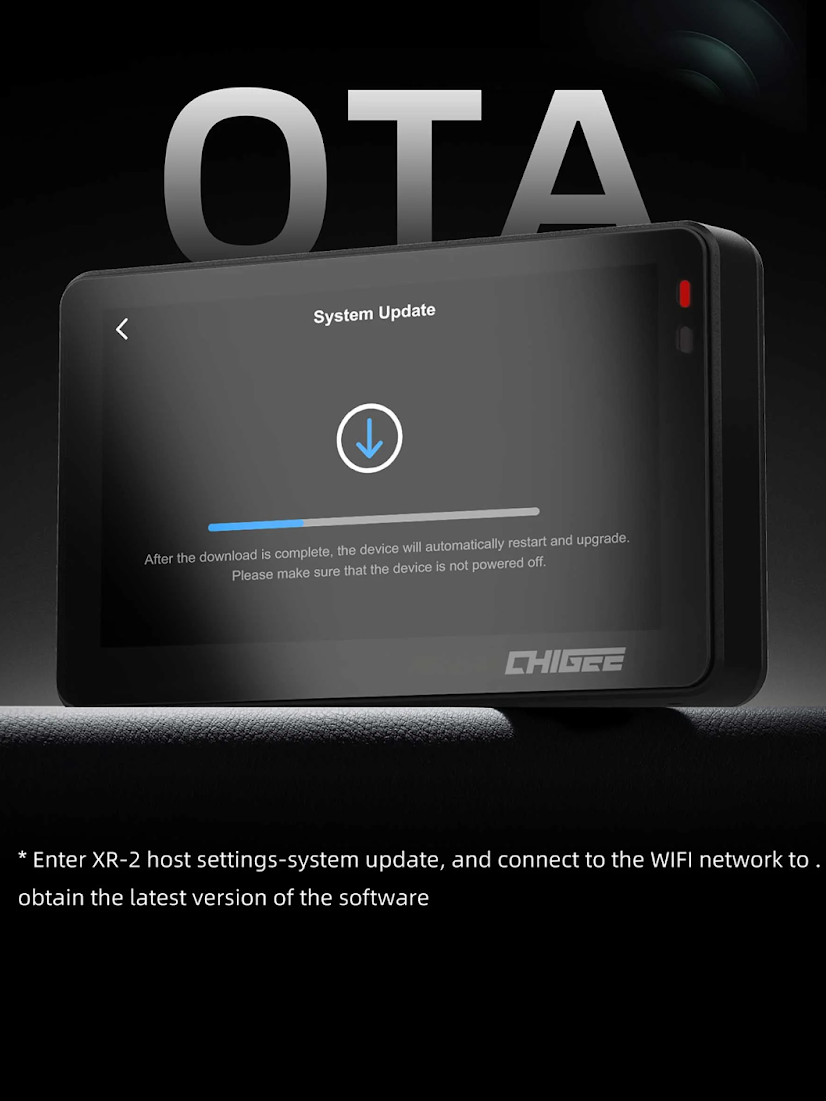
By sticking to the fundamentals, the XR-2 delivers lasting value that meets long-term needs. Riders can rely on it for years, without worrying about it becoming outdated or ineffective as trends shift.
Looking for a one-stop resource on rider navigation? The best motorcycle GPS units of 2025 guide highlights the top options across touring, ADV, and budget categories.
Making the Right Choice for Your Riding
The Chigee XR-2 succeeds by recognizing that not every rider needs or wants a tablet-sized electronics system dominating their handlebars. For riders of classic machines like my XJR 400, City commuters, smaller displacement bikes, or anyone who values proportional design and essential functionality, the XR-2 delivers exactly what’s needed without excess complexity or bulk.
Choose the Chigee XR-2 if:
- You ride a classic, vintage, or smaller displacement motorcycle
- Clean, proportional installations matter more than maximum screen size
- You need reliable all-weather performance with IP68 protection
- Built-in GPS independence from smartphone connectivity appeals to you
- You want dual camera documentation without system complexity
- Responsive performance and bright screen visibility are priorities
- You value long-term reliability over cutting-edge features
Consider Other Options if:
- You need tablet-sized displays for detailed mapping
- Advanced rider aid integration is essential
- You regularly use complex navigation features requiring larger screens
- Maximum feature count matters more than system integration
- Your bike has unlimited space for electronics mounting
Feature Summary
| Feature | Chigee XR-2 Specification |
| Screen Size | 4.3-inch display |
| Brightness | 1400 nits (excellent sunlight visibility) |
| Waterproof Rating | IP68 (highest available) |
| GPS | Built-in, independent operation |
| Cameras | Dual 1080p (front and rear) |
| Smartphone Integration | Wireless Apple CarPlay/Android Auto |
| Smart Features | Automatic day/night mode switching |
| Dashboard Functions | Odometer, trip tracking, ride metrics |
| Installation | Integrated design, minimal wiring |
| Build Quality | Premium construction for long-term use |
Final Perspective
After installing and using the Chigee XR-2 on my 1990 Yamaha XJR 400, it represents a successful execution of focused design philosophy. Rather than attempting to compete with premium systems on feature count, it delivers essential functionality with exceptional reliability and build quality that respects the character of classic motorcycles.
The key insight from using the XR-2 on the XJR 400 is that sometimes the best electronics system is the one that integrates so seamlessly you forget it’s there until you need it. The XR-2 enhances your riding experience without dominating it, provides essential modern functionality without overwhelming complexity, and delivers long-term reliability without requiring constant attention or maintenance.
For riders of classic bikes like the XJR 400 who’ve been underserved by the premium electronics market’s focus on large adventure machines, the XR-2 offers a compelling alternative that respects both your motorcycle’s character and your practical needs. It proves that you don’t need to choose between modern functionality and proportional design—you can have both when the system is designed with your specific requirements in mind.
The XR-2 is a compact, handlebar-mount CarPlay / Android Auto “smart riding” display and dashcam unit for motorcycles. It features a 4.3-inch touchscreen that mirrors your smartphone interface, dual front/rear cameras for recording, and optional external tire pressure sensors for real-time monitoring. It integrates navigation, ride logging, and safety features into one compact system.
- 1400 nits brightness, daylight ready
- Dual cams for recording + safety
- CarPlay / Android Auto support
- Optional TPMS external sensors
- IP68 water + dust resistant
- More affordable than flagships
- No buttons, needs BT remote
- No blind-spot detection
The choice isn’t about finding the system with the most features—it’s about finding the system that delivers exactly what you need with exceptional reliability and integration. The Chigee XR-2 succeeds at this fundamental level, making it an excellent choice for riders who value substance over specification sheets.
Related
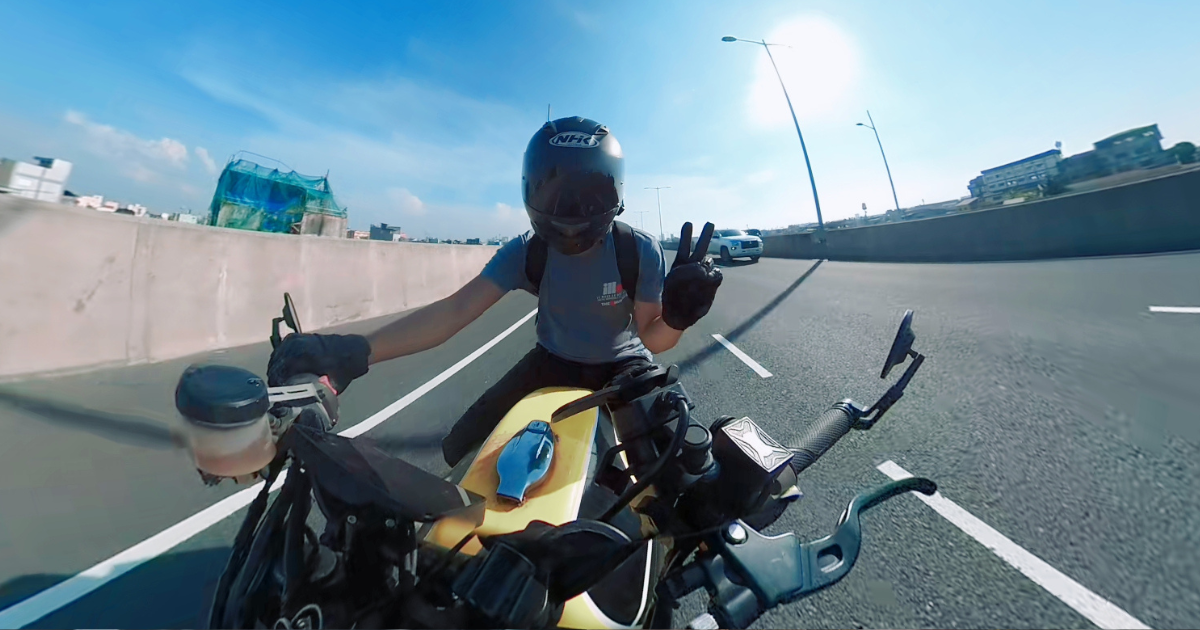
Pando Moto Onyx 02 Gloves Review: The Break-In That Changed Me
Too tight at first, perfectly molded after break-in. Quality leather gloves worth the patience for classic motorcycle riders.

